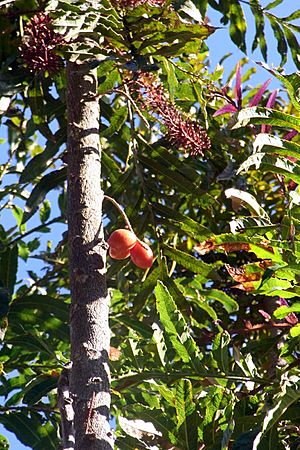Hicksbeachia facts for kids
Quick facts for kids Hicksbeachia |
|
|---|---|
 |
|
| Hicksbeachia pinnatifolia | |
| Scientific classification |
|
| Kingdom: | Plantae |
| Clade: | Tracheophytes |
| Clade: | Angiosperms |
| Clade: | Eudicots |
| Order: | Proteales |
| Family: | Proteaceae |
| Subfamily: | Grevilleoideae |
| Tribe: | Macadamieae |
| Subtribe: | Gevuininae |
| Genus: | Hicksbeachia F.Muell. |
| Species | |
|
See text |
|
Hicksbeachia is a small group of two types of trees. They belong to the Proteaceae plant family. You can find them growing naturally in the rainforests of northern New South Wales and southeastern Queensland in Australia. People often call them "red bopple nut" or "beef nut" because their fruits are a bright red color.
Contents
About the Name and History
Ferdinand von Mueller gave the name Hicksbeachia to this group of trees in 1883. He named it after Michael Hicks Beach, who was a very important government official at the time, called the Secretary of State for the Colonies. Mueller named several other plant groups after similar officials.
At first, only one type of Hicksbeachia was known, called Hicksbeachia pinnatifolia. But in 1988, a scientist named Peter Weston found another type in north Queensland. He named it H. pilosa.
Scientists have studied the genes and shapes of these trees. They found that Hicksbeachia is most closely related to another plant group called Bleasdalea. These two groups separated from each other about 15 million years ago. Even older ancestors of these plants are thought to have started in South America about 35 million years ago.
Scientists have also found very old pollen that looks a lot like the pollen from Hicksbeachia and Gevuina trees. This pollen has been found in rocks from about 100 million years ago to 35 million years ago in places like the northern Antarctic Peninsula and Australia. Also, fossilized leaves that look like Hicksbeachia leaves have been found in New Zealand from about 15 million years ago.
Types of Hicksbeachia Trees
There are two known species (types) of Hicksbeachia:
- Hicksbeachia pilosa P.H.Weston
- Hicksbeachia pinnatifolia F.Muell.
Neither of these two types of trees is very common. However, H. pinnatifolia is grown more often by people because its nuts are safe to eat.
What These Trees Look Like
Both types of Hicksbeachia are small trees. They usually have one main trunk and can grow up to about 15 meters (50 feet) tall. Their leaves are shaped like feathers, with many smaller leaflets arranged along a central stem. These leaves grow one after another along the branches.
The flowers of these trees grow in long, hanging bunches. Around nightfall, the flowers give off strong smells. Some people say the smell is like honey, while others describe it as smelling like sour milk, cat's urine, or even mice!
Where They Live
Both types of Hicksbeachia trees are found in the rainforests of eastern Australia.
- H. pinnatifolia grows in the northeastern part of New South Wales and the southeastern part of Queensland.
- H. pilosa is found further north, in the Wet Tropics rainforests of northeastern Queensland.
See also
 In Spanish: Hicksbeachia para niños
In Spanish: Hicksbeachia para niños

